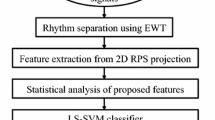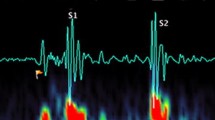Abstract
This paper presents a novel method for automatic identification of motion artifact beats in ECG recordings. The proposed method is based on the ECG complexes clustering, fuzzy logic and multi-parameters decision. Firstly, eight simulated datasets with different signal-to-noise ratio (SNR) were built for identification experiments. Results show that the identification sensitivity of our method is sensitive to SNR levels and acts like a low-pass filter that matches the cardiologists’ recognition, while the Norm FP rate and PVB FP rate keep significantly low regardless of SNR. Furthermore, a simulated dataset including random durations of motion activities superimposed segments and two clinical datasets acquired from two different commercial recorders were adopted for the evaluation of accuracy and robustness. The overall identification results on these datasets were: sensitivity >94.69%, Norm FP rate <0.60% and PVB FP rate <2.65%. All the results were obtained without any manual threshold adjustment according to the priori information, thus dissolving the drawbacks of previous published methods. Additionally, the total cost time of our method applied to 24 h recordings is less than 1 s, which is extremely suitable in the situation of magnanimity data in long-term ECG recordings.









Similar content being viewed by others
References
Baxt, W. G. Application of artificial neural networks to clinical medicine. Lancet 346(8983):1135–1138, 1995.
Bian, Y., H. Yang, W. He, and J. Wang. A method base on least square algorithm for discriminating artifacts in dynamic electrocardiogram signals. J. Biomed. Eng. 24(5):1031, 2007.
Burbank, D. P., and J. G. Webster. Reducing skin potential motion artefact by skin abrasion. Med. Biol. Eng. Comput. 16(1):31–38, 1978.
Chouakri, S., F. Bereksi-Reguig, and A. Taleb-Ahmed. QRS complex detection based on multi wavelet packet decomposition. Applied Mathematics and Computation 217(23):9508–9525, 2011.
Friesen, G. M., T. C. Jannett, M. A. Jadallah, S. L. Yates, S. R. Quint, and H. T. Nagle. A comparison of the noise sensitivity of nine QRS detection algorithms. IEEE Trans. Biomed. Eng. 37(1):85–98, 1990.
Goldberger, A. L., L. A. N. Amaral, L. Glass, J. M. Hausdorff, P. C. Ivanov, R. G. Mark, J. E. Mietus, G. B. Moody, C. K. Peng, and H. E. Stanley. PhysioBank, PhysioToolkit, and PhysioNet: components of a new research resource for complex physiologic signals. Circulation 101(23):e215, 2000.
Goovaerts, H. G., H. H. Ros, T. J. Van Den Akker, and H. Schneider. A digital QRS detector based on the principle of contour limiting. IEEE Trans. Biomed. Eng. 2:154–160, 1976.
Hadj Slimane, Z. E., and A. Nait-Ali. QRS complex detection using Empirical Mode Decomposition. Digit. Signal Process. 20(4):1221–1228, 2010.
Hamilton, P. S. Open Source ECG Analysis Software Documentation. Somerville, MA, USA: EP Limited, 2002.
Hamilton, P. S., and W. J. Tompkins. Quantitative investigation of QRS detection rules using the MIT/BIH arrhythmia database. IEEE Trans. Biomed. Eng. 12:1157–1165, 1986.
He, T., G. Clifford, and L. Tarassenko. Application of independent component analysis in removing artefacts from the electrocardiogram. Neural Comput. Appl. 15(2):105–116, 2006.
Hong, H., and M. Liang. K-hybrid: a kurtosis-based hybrid thresholding method for mechanical signal denoising. J. Vib. Acoust. 129:458, 2007.
Hyvärinen, A., J. Karhunen, and E. Oja. Independent Component Analysis. New York: Wiley-Interscience, 2001.
Lagerholm, M., C. Peterson, G. Braccini, L. Edenbrandt, and L. Sornmo. Clustering ECG complexes using Hermite functions and self-organizing maps. IEEE Trans. Biomed. Eng. 47(7):838–848, 2000.
Li, Y. T., Y. S. Qi, and Z. Y. Xiao. Artifacts discriminating of dynamic electrocardiogram signals based on wavelet transform [J]. Comput. Eng. 35(18):269–271, 2009.
Mendel, J. M. Tutorial on higher-order statistics (spectra) in signal processing and system theory: Theoretical results and some applications. Proc. IEEE 79(3):278–305, 1991.
Milanesi, M., N. Martini, N. Vanello, V. Positano, M. F. Santarelli, and L. Landini. Independent component analysis applied to the removal of motion artifacts from electrocardiographic signals. Med. Biol. Eng. Comput. 46(3):251–261, 2008.
Moody, G. B., and R. G. Mark. The impact of the MIT-BIH arrhythmia database. IEEE Eng. Med. Biol. Mag. 20(3):45–50, 2001.
Moody, G. B., W. Muldrow, and R. G. Mark. A noise stress test for arrhythmia detectors. Comput. Cardiol. 11(3):381–384, 1984.
Pan, J., and W. J. Tompkins. A real-time QRS detection algorithm. IEEE Trans. Biomed. Eng. 3:230–236, 1985.
Raya, M. A. D., and L. G. Sison. Adaptive noise cancelling of motion artifact in stress ECG signals using accelerometer. In: IEEE Proceedings of the Second Joint EMBC/BMES Conference, Vol. 1752, 2002, pp. 1756–1757.
Sharma, L., S. Dandapat, and A. Mahanta. ECG signal denoising using higher order statistics in Wavelet subbands. Biomed. Signal Process. Control 5(3):214–222, 2010.
Tompkins, W. J. Biomedical Digital Signal Processing: C-Language Examples and Laboratory Experiments for the IBM PC. Englewood Cliffs: Prentice Hall, 1993.
Webster, J. G. Reducing motion artifacts and interference in biopotential recording. IEEE Trans. Biomed. Eng. 31(12):823–826, 1984.
Yeh, Y. C., and W. J. Wang. QRS complexes detection for ECG signal: the difference operation method. Comput. Methods Programs Biomed. 91(3):245–254, 2008.
Yoon, S. W., S. D. Min, Y. H. Yun, S. Lee, and M. Lee. Adaptive motion artifacts reduction using 3-axis accelerometer in e-textile ECG measurement system. J. Med. Syst. 32(2):101–106, 2008.
Yoon, S. W., H. S. Shin, S. D. Min, and M. H. Lee. Adaptive motion artifacts reduction algorithm for ECG signal in textile wearable sensor. IEICE Electron. Express 4(10):312–318, 2007.
Author information
Authors and Affiliations
Corresponding author
Additional information
Associate Editor Xiaoxiang Zheng oversaw the review of this article.
Rights and permissions
About this article
Cite this article
Tu, Y., Fu, X., Li, D. et al. A Novel Method for Automatic Identification of Motion Artifact Beats in ECG Recordings. Ann Biomed Eng 40, 1917–1928 (2012). https://doi.org/10.1007/s10439-012-0551-2
Received:
Accepted:
Published:
Issue Date:
DOI: https://doi.org/10.1007/s10439-012-0551-2




